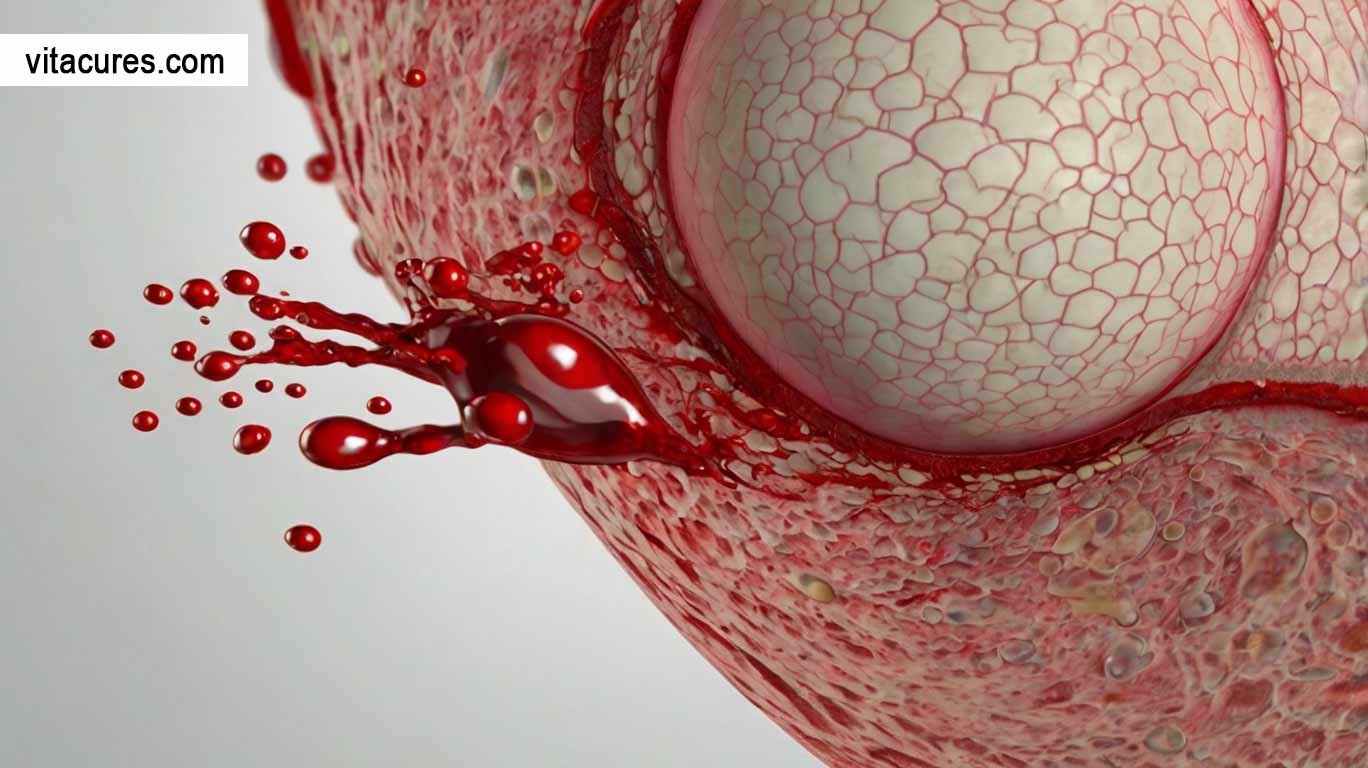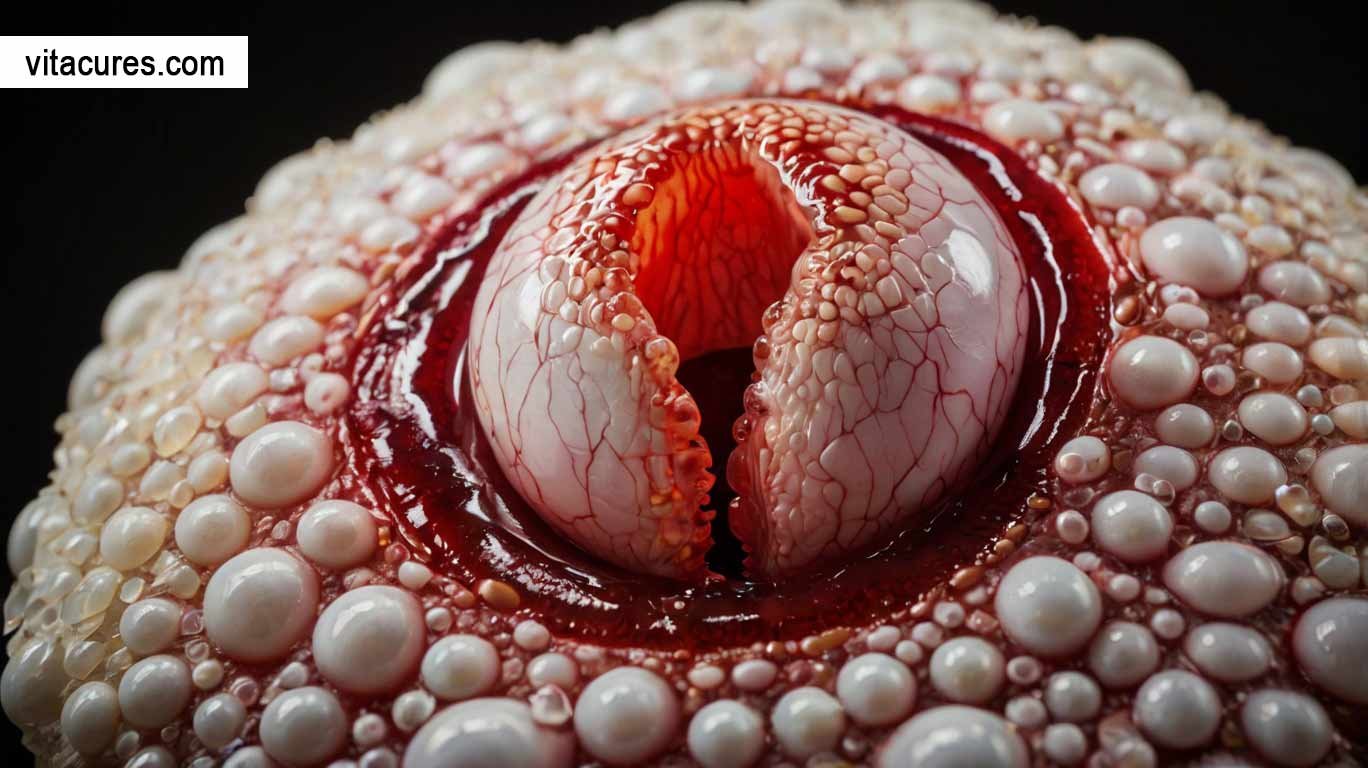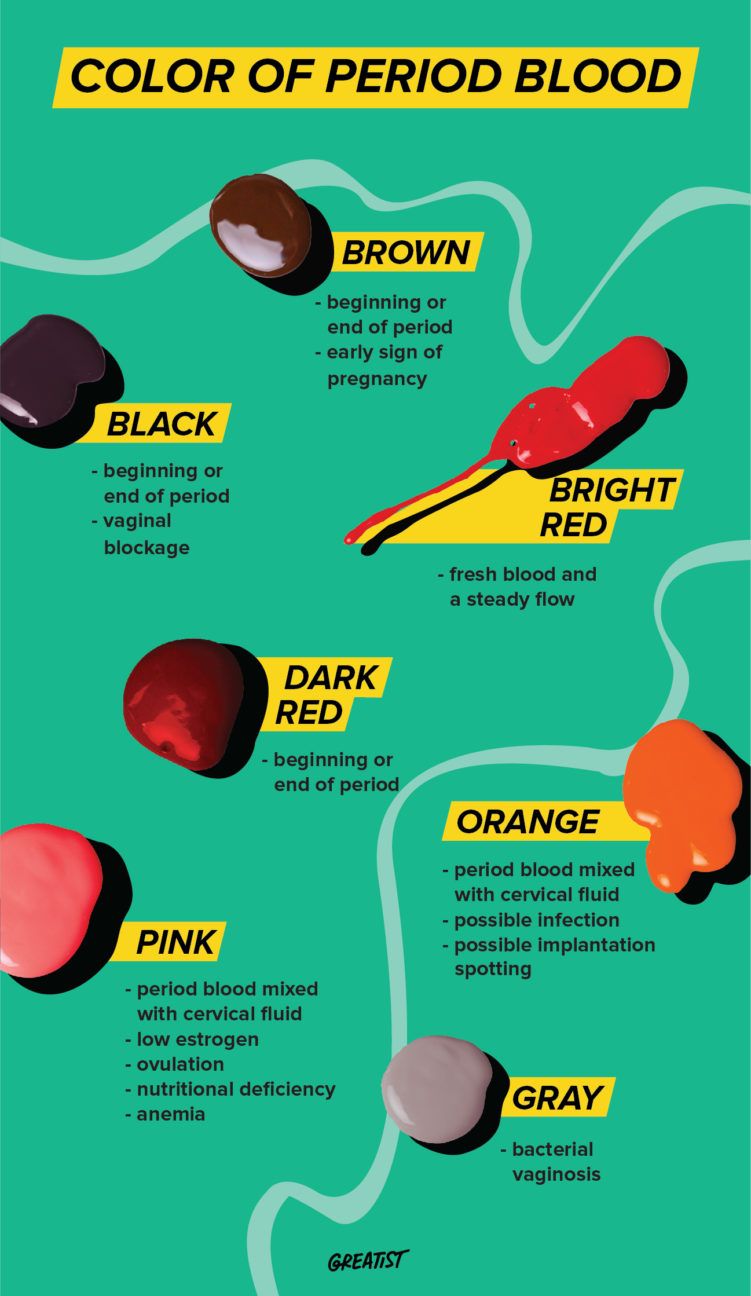Ovulation bleeding refers to light spotting that can occur midway through the menstrual cycle. It usually lasts a few hours to a couple of days.
Ovulation is a key phase in the menstrual cycle, marked by the release of an egg from the ovary. Some women experience ovulation bleeding, which is a normal physiological occurrence. This spotting happens due to hormonal changes as estrogen peaks before ovulation.
It’s typically lighter and shorter than menstrual bleeding, often causing little concern. Recognizing ovulation bleeding can help women track their fertility and understand their cycle better. While it’s generally harmless, any unusual bleeding should be discussed with a healthcare professional to rule out other issues. Understanding this phenomenon can empower women in their reproductive health journey.
What Is Ovulation Bleeding?

Ovulation bleeding is a natural occurrence in some women’s menstrual cycles. It happens when an egg is released from the ovary. This process is called ovulation. Some women notice light bleeding or spotting during this time. Understanding ovulation bleeding is important for tracking fertility.
Ovulation bleeding refers to light spotting that occurs around the time of ovulation. It typically lasts a few hours to a couple of days. This bleeding can be confused with a period. However, it is usually lighter and shorter.
- Hormonal changes: Fluctuations in estrogen and progesterone can trigger bleeding.
- Follicle rupture: The release of an egg can cause small blood vessels to break.
- Cervical irritation: The cervix may become sensitive during ovulation.
Symptoms Of Ovulation Bleeding
Women may experience various symptoms, including:
- Light spotting: Often pink or brown in color.
- Cramping: Mild discomfort may occur.
- Changes in cervical mucus: The mucus may become clearer and stretchier.
How To Differentiate From Menstrual Bleeding
| Feature | Ovulation Bleeding | Menstrual Bleeding |
|---|---|---|
| Color | Light pink or brown | Bright red |
| Duration | 1-3 days | 3-7 days |
| Flow | Very light | Varies from light to heavy |
Consult a doctor if:
- Bleeding is heavy or lasts more than a few days.
- Severe pain accompanies the bleeding.
- Bleeding occurs outside your usual cycle.
Causes Of Ovulation Bleeding
Ovulation bleeding is a common occurrence for many women. It happens when light spotting or bleeding occurs during ovulation. Understanding the causes of ovulation bleeding can help women recognize their menstrual cycle better. This knowledge can aid in identifying fertile days and improve overall reproductive health.
Hormonal Changes
Hormonal changes play a significant role in ovulation bleeding. The menstrual cycle is regulated by various hormones, mainly estrogen and progesterone. These hormones fluctuate throughout the cycle, leading to different physical changes in the body.
- Estrogen Levels: During the first half of the cycle, estrogen levels rise. This rise helps thicken the uterine lining.
- Progesterone Levels: After ovulation, progesterone kicks in to stabilize the lining. If pregnancy does not occur, these levels drop.
- Timing: Ovulation typically occurs around the middle of the cycle, usually 14 days before the next period.
When estrogen levels peak right before ovulation, some women may experience light bleeding. This is known as ovulation bleeding. Understanding these hormonal changes helps women track their cycles and recognize signs of ovulation.
| Hormone | Role in Cycle | Effect on Bleeding |
|---|---|---|
| Estrogen | Thickens uterine lining | Can cause light spotting during peak |
| Progesterone | Stabilizes uterine lining | Drop may cause light bleeding |
Follicle Rupture
Follicle rupture is another key cause of ovulation bleeding. Each month, follicles in the ovaries mature and release an egg. This process is called ovulation.
When a follicle releases an egg, it can sometimes cause slight bleeding. This bleeding may occur due to the following reasons:
- Follicle Growth: As the follicle grows, it can stretch and become fragile.
- Rupture: The rupture of the follicle releases the egg and may lead to light spotting.
- Fluid Release: Fluid from the follicle can mix with blood, causing the spotting.
Some women may notice this bleeding as brown or pink discharge. It usually lasts for a short time, often a day or two. Monitoring this can help women understand their ovulation timing better.
Overall, recognizing the signs of follicle rupture can aid in family planning and tracking fertility.
Symptoms To Watch For

Ovulation bleeding can be a surprising experience for many women. Recognizing the symptoms to watch for is vital. Understanding these signs helps you know your body better. This knowledge can guide your reproductive health decisions.
Timing
Timing plays a crucial role in identifying ovulation bleeding. This type of bleeding typically occurs midway through your menstrual cycle. For most women, this happens around day 14 in a 28-day cycle. Knowing your cycle length helps pinpoint the right time. Here are some key points to consider:
- Ovulation usually occurs about 14 days before your next period.
- Bleeding may last from a few hours to 3 days.
- Some women notice spotting, while others see a light flow.
Tracking your cycle can help you identify these patterns. You can use a simple table to visualize your cycle:
| Day | Event |
|---|---|
| 1-5 | Menstrual Period |
| 6-12 | Follicular Phase |
| 13-15 | Ovulation |
| 16-28 | Luteal Phase |
By marking these dates, you can better predict your ovulation bleeding. Note any changes in timing. This can help in recognizing your unique pattern.
Color And Consistency
The color and consistency of ovulation bleeding also provide valuable clues. This bleeding often appears as light pink or brown. It may differ from your regular period. Pay attention to the following details:
- Light Pink: Indicates fresh blood, often seen during ovulation.
- Brown: Suggests older blood, which is normal.
- Consistency can be watery or slightly thicker.
Here’s a quick reference for understanding colors:
| Color | Meaning |
|---|---|
| Bright Red | New Blood |
| Light Pink | Ovulation Bleeding |
| Brown | Old Blood |
Noticing these colors and their consistency can help you differentiate ovulation bleeding from your menstrual period. Keeping a journal of these observations can help track your cycle better.

Credit: greatist.com
Difference From Menstrual Bleeding
Ovulation bleeding is a light spotting that occurs during ovulation. It is often confused with menstrual bleeding. Understanding the difference can help you track your cycle better. While both involve bleeding, they have distinct characteristics. Knowing these differences helps in identifying your body’s signals.
Duration
Ovulation bleeding typically lasts for a shorter time than menstrual bleeding. Here’s a quick comparison:
| Type of Bleeding | Duration |
|---|---|
| Ovulation Bleeding | 1 to 3 days |
| Menstrual Bleeding | 3 to 7 days |
Key points about duration:
- Ovulation bleeding lasts only a few days.
- Menstrual bleeding can last longer, up to a week.
- Menstrual bleeding signals the end of a cycle.
Noticing how long each type lasts can help you understand your cycle. If you experience spotting that lasts longer than three days, consult a healthcare professional.
Intensity
The intensity of ovulation bleeding is usually much lighter than menstrual bleeding. This means it might not require heavy protection. Here’s a comparison:
| Type of Bleeding | Intensity |
|---|---|
| Ovulation Bleeding | Light spotting |
| Menstrual Bleeding | Moderate to heavy flow |
Important points about intensity:
- Ovulation bleeding is usually light pink or brown.
- Menstrual bleeding is often bright red and heavier.
- Ovulation bleeding may require a panty liner.
- Menstrual bleeding may need pads or tampons.
Recognizing the intensity can assist in determining your cycle phase. If you notice changes in your bleeding patterns, it may be worth discussing with a doctor.
When To Seek Medical Advice
Ovulation bleeding is a light spotting that some women experience during their menstrual cycle. It usually happens around the time of ovulation. While it is often normal, some signs may indicate a need for medical advice. Knowing when to seek help is important for your health. Pay attention to unusual symptoms. They may require further investigation.
Severe Pain
Experiencing severe pain during ovulation can be alarming. While some women feel mild discomfort, severe pain is different. It may indicate an underlying issue. Here are some reasons to consider:
- Ovarian cysts: These fluid-filled sacs can cause intense pain.
- Endometriosis: This condition occurs when tissue grows outside the uterus.
- Pelvic inflammatory disease: An infection can lead to severe pain.
It’s crucial to monitor the pain level. If it disrupts your daily life, seek medical advice. Doctors may perform tests to find the cause. Early intervention can prevent complications.
Use the following table to understand pain levels:
| Pain Level | Action Required |
|---|---|
| Mild | No action needed, monitor symptoms. |
| Moderate | Consider over-the-counter pain relief. |
| Severe | Contact a healthcare provider immediately. |
Prolonged Bleeding
Prolonged bleeding during ovulation is another sign to watch. Normally, ovulation bleeding lasts only a few hours to a couple of days. If it lasts longer, it could signal a problem. Possible causes include:
- Hormonal imbalances: Fluctuations in hormones can lead to extended bleeding.
- Uterine fibroids: These non-cancerous growths can cause heavy bleeding.
- Miscarriage: Early pregnancy loss may present as prolonged bleeding.
Consult a healthcare professional if you notice:
- Bleeding lasting more than three days.
- Heavy bleeding that soaks through pads or tampons.
- Spotting after your period has ended.
Understanding your body is essential. Always listen to its signals. If you experience prolonged bleeding, take action. Early diagnosis can improve treatment outcomes.

Credit: www.thewellnesscorner.com
Natural Remedies And Care
Ovulation bleeding is a light spotting that some women experience during their ovulation cycle. It usually occurs around the middle of the menstrual cycle. While it is often harmless, many seek natural remedies and care to ease any discomfort or concerns associated with it. Simple lifestyle changes and herbal options can help manage symptoms effectively.
Dietary Changes
Diet plays a crucial role in managing ovulation bleeding. Eating the right foods can help balance hormones and improve overall health.
Here are some key dietary changes to consider:
- Increase fruits and vegetables: They provide essential vitamins and minerals.
- Include whole grains: Foods like brown rice and oats can stabilize blood sugar.
- Healthy fats: Sources like avocados and nuts support hormone production.
- Stay hydrated: Drinking enough water helps maintain bodily functions.
Consider the following table for specific foods that may aid in managing ovulation:
| Food Group | Examples | Benefits |
|---|---|---|
| Fruits | Bananas, Berries | Rich in antioxidants and vitamins |
| Vegetables | Spinach, Broccoli | High in fiber and nutrients |
| Whole Grains | Quinoa, Barley | Support hormone balance |
| Proteins | Chicken, Lentils | Promote muscle health |
Incorporating these foods can lead to better regulation of your cycle. A balanced diet can significantly impact your body’s response during ovulation.
Herbal Supplements
Herbal supplements can offer support for women experiencing ovulation bleeding. Many herbs have properties that help regulate hormones and relieve symptoms.
Here are some popular herbal supplements:
- Chaste Tree (Vitex): Balances hormones and may reduce spotting.
- Red Clover: Contains phytoestrogens that support reproductive health.
- Ginger: Helps improve circulation and reduce inflammation.
- Raspberry Leaf: Strengthens uterine muscles and regulates cycles.
It’s important to consider the following points:
- Consult a healthcare professional before starting any herbal supplements.
- Follow recommended dosages to avoid side effects.
- Monitor your body’s response to the herbs.
Using herbal remedies can be a natural way to manage symptoms. Always choose quality sources for herbal products to ensure effectiveness.
Impact On Fertility
Ovulation bleeding can be a surprising experience for many women. It usually occurs around the midpoint of the menstrual cycle. This slight spotting can indicate that ovulation is happening. Understanding ovulation bleeding is vital for women trying to conceive. It can also impact overall fertility. Recognizing this sign helps in planning for pregnancy.
Ovulation Tracking
Tracking ovulation is essential for couples trying to conceive. It helps identify the most fertile days. Here are some methods to track ovulation:
- Calendar Method: Mark your cycle on a calendar.
- Basal Body Temperature: Take your temperature every morning.
- Ovulation Predictor Kits: Use kits to test hormone levels.
- Cervical Mucus Monitoring: Observe changes in discharge.
Benefits of Ovulation Tracking:
| Benefit | Description |
|---|---|
| Improved Timing | Identify your most fertile days for conception. |
| Increased Awareness | Understand your body’s cycles better. |
| Health Monitoring | Spot irregularities that may need attention. |
By tracking ovulation, you can maximize your chances of getting pregnant. It provides clarity about your cycle and fertility.
Timing Intercourse
Timing intercourse correctly is crucial for conception. The best time is during the ovulation window. This window lasts about six days, including the day of ovulation.
Here are some tips for timing intercourse:
- Know Your Cycle: Understand your average cycle length.
- Use Ovulation Tests: Determine peak fertility days.
- Have Regular Intercourse: Aim for every 2-3 days.
Recommended Timing:
| Day of Cycle | Recommended Action |
|---|---|
| Day 12-14 | Have intercourse every day or every other day. |
| Day 15 | Monitor for ovulation signs. |
Correctly timing intercourse increases the chance of sperm meeting the egg. This can lead to successful conception. Understanding your cycle and ovulation can make a significant difference.
Common Myths Debunked
Ovulation bleeding can confuse many women. Myths surrounding it often lead to misunderstandings. Knowing the truth helps to clarify what ovulation bleeding really is.
Ovulation Bleeding Means Pregnancy
Many believe that ovulation bleeding indicates pregnancy. This idea is a common myth. In reality, ovulation bleeding occurs when an egg is released from the ovary. Here are some key points to understand:
- Timing: Ovulation usually happens in the middle of the menstrual cycle.
- Light Spotting: Bleeding during ovulation is typically light and short-lived.
- Not a Sign: Ovulation bleeding does not confirm pregnancy.
Some women may notice spotting around ovulation. This can be due to hormonal changes. It is important to know:
| Symptom | Possible Meaning |
|---|---|
| Light Spotting | Ovulation |
| Heavy Bleeding | Menstrual Cycle |
| No Bleeding | Normal Variation |
Understanding these points helps separate fact from fiction. Ovulation bleeding alone does not indicate pregnancy.
All Women Experience It
Another myth is that all women experience ovulation bleeding. This is not true. The experience of ovulation varies greatly among women. Here are some important facts:
- Variability: Only about 20% of women notice ovulation bleeding.
- Individual Differences: Hormone levels affect whether a woman experiences this symptom.
- Not Abnormal: Not having ovulation bleeding is completely normal.
Some women may have heavy periods. Others may have light or no periods at all. This variation is normal and does not indicate any health issues. Here are some reasons why women might not experience ovulation bleeding:
- Hormonal Imbalances
- Age
- Stress
- Health Conditions
Recognizing these facts helps women understand their bodies better. Everyone’s experience with ovulation is unique.
:max_bytes(150000):strip_icc()/Ovulation-bleeding-5182477-DD-V2-3a74e38028f4459c8b10d9cc29707fd5.jpg)
Credit: www.verywellhealth.com
Frequently Asked Questions
What Is Ovulation Bleeding?
Ovulation bleeding is light spotting that occurs mid-cycle. It typically happens around the time of ovulation, which is when an egg is released. This bleeding is usually pink or brown in color and lasts a few hours to a couple of days.
It is generally considered normal and not a cause for concern.
Is Ovulation Bleeding Common?
Yes, ovulation bleeding is relatively common among women. About 20% of women may experience it during their menstrual cycle. The occurrence can vary based on hormonal fluctuations and individual body responses. If it is persistent or accompanied by pain, consult a healthcare professional for guidance.
How Long Does Ovulation Bleeding Last?
Ovulation bleeding usually lasts between a few hours to three days. It is lighter than a menstrual period and often resolves quickly. The duration can vary based on individual hormonal levels and cycle regularity. If bleeding persists beyond this timeframe, it’s advisable to seek medical advice.
What Causes Ovulation Bleeding?
Ovulation bleeding is caused by hormonal changes during the menstrual cycle. As estrogen levels rise, it can lead to slight shedding of the uterine lining. This is a normal response to ovulation. Other factors, such as stress or changes in birth control, may also contribute.
Conclusion
Understanding ovulation bleeding can help you identify your menstrual cycle better. It is often normal and can vary from person to person. Keep track of your symptoms and consult a healthcare professional if you have concerns. Knowledge empowers you to take charge of your reproductive health confidently.
Stay informed and proactive!



